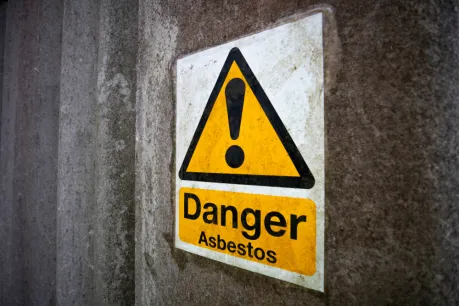The EPA Finalizes Asbestos Ban and Phase-Out Rule

Injured?
On Monday, March 18, 2024, The U.S. Environmental Protection Agency (EPA) announced a comprehensive ban on the use of chrysotile asbestos. This action marks a major milestone for the nation's chemical safety efforts, as the EPA has fought for more than three decades to ban the carcinogenic minerals. The efforts to ban the hazardous minerals began in 1989 when the EPA first initially banned asbestos; however, the rule was largely overturned by a 1991 Court of Appeals decision that weakened the EPA's authority under TSCA to address risks to human health from asbestos or other existing chemicals.
Now, the ban on ongoing asbestos use is the first rule to be finalized under the 2016 amendments to the nation's chemical safety law, the Toxic Substances Control Act (TSCA), which received near-unanimous support in both the U.S. House of Representatives and the Senate.
What Is Asbestos?
Asbestos is a term applied to six cancer-causing minerals in rocks and soil, including actinolite, amosite, anthophyllite, chrysotile, crocidolite, and tremolite. Asbestos is made up of long, thin, and very strong fibers that do not evaporate or dissolve in water. The mineral fibers are also known for their carcinogenic properties, and their resistance to heat, chemicals, electricity, and corrosion.
To date, asbestos is banned in more than 50 countries, whereas chrysotile asbestos is the only known form of asbestos currently used in the United States, and imported from Brazil and Russia. The hazardous mineral is mainly used by the chlor-alkali industry, which produces such as asbestos diaphragms, sheet gaskets, brake blocks, aftermarket automotive brakes/linings, other vehicle friction products, and other gaskets.
Asbestos Causes Mesothelioma
As mentioned, asbestos is a highly carcinogenic mineral and was commonly used in home insulation and other products until it was regulated in the 1970s. Though its use of asbestos has declined, each year, thousands of Americans still grapple with asbestos-related diseases, the most common being mesothelioma, a fatal form of cancer. According to the Mayo Clinic, the symptoms may vary depending on the type of mesothelioma.
Symptoms for pleural mesothelioma, also known as the most common form of mesothelioma occurring in the lungs, can include chest pain, excessive sweating, fluid in the lungs, shortness of breath, and wheezing. Other forms of mesothelioma include:
- Peritoneal mesothelioma, which occurs in tissue in the abdomen.
- Pericardial mesothelioma, which affects the tissue surrounding the heart.
- Mesothelioma of tunica vaginalis, which affects the tissue surrounding the testicles.
Cancer.Net reports that 3,000 people are diagnosed with mesothelioma each year in the United States due to exposure to asbestos, and in 2022, an estimated 12,431 people died of mesothelioma in the U.S. alone. If you believe you have been exposed to asbestos and are exhibiting signs of mesothelioma, contact your doctor right away.
What Does the New Chrysotile Asbestos Ban Do?
Under the Toxic Substances Control Act amendments in 2016, the EPA was allowed more authority to assess and regulate various chemicals like polychlorinated biphenyls (PCBs), radon, lead-based paint, and asbestos. Through the TSCA, the EPA determined that the mineral fiber chrysotile asbestos, despite its limited use in chemical or chlor-alkali manufacturing, the mineral fibers continued to have "unreasonable risks."
In 2022, the EPA proposed a final rule to ban asbestos, which remained under review by industry leaders before it was finalized earlier this year. Under the March 2024 asbestos ban, all chrysotile asbestos imports will be immediately halted, and the EPA will work to create strict workplace safety measures to protect workers from asbestos exposure as it begins to phase out the use of asbestos. In terms of phasing out the use of chrysotile asbestos, all industries still using the mineral fibers will be assigned various timelines.
Once the EPA rule is published, the ban on asbestos imports from the chlor-alkali industry will immediately halt; however, there will be an initial prohibition phase on chlor-alkali's use of the mineral fibers, allowing it the opportunity to switch to an alternative material. The EPA is calling this "a reasonable transition period," which will last between 5 and 12 years. A ban on asbestos in oilfield brake blocks, aftermarket automotive brakes and linings, and other gaskets will officially take effect in six months, while the ban on other uses of asbestos will take effect in two years.
The ruling also allows asbestos-containing sheet gaskets to be used at the U.S. Department of Energy's Savannah River Site in South Carolina until 2037 to ensure that safe disposal of nuclear materials can continue on schedule.
What’s Next for Asbestos in the United States?
Many have praised the ruling as a significant step in the right direction, "With today's ban, EPA is finally slamming the door on a chemical so dangerous that has been banned in over 50 countries," said EPA Administrator Michael S. Regan. While this ban is considered a major milestone, some advocates have raised concerns over the extended timeline and are calling for a complete ban on asbestos.
Linda Reinstein, the Co-Founder and President of The Asbestos Disease Awareness Organization (ADAO), expressed alarm regarding the "unnecessarily long transition period," claiming it would create inconsistent compliance deadlines for certain asbestos users. The ADAO is calling on Congress and other lawmakers to pass the Alan Reinstein Ban Asbestos Now Act, which would "prohibit the manufacture, process, use, and distribution in commerce of commercial asbestos or any mixture or article containing commercial asbestos."
Currently, the agency is also evaluating other types of asbestos fibers (in addition to legacy uses and associated disposal of chrysotile and asbestos-containing talc) in the second part of its asbestos risk evaluation. The agency is expected to release "part 2" of the draft risk evaluation soon and will publish the final risk evaluation by the end of the year.
For now, if you or a loved one have been exposed to asbestos and were diagnosed with mesothelioma, we may be able to help you. To learn more information about the latest asbestos ban or to speak with an attorney, complete our free, no-obligation case evaluation form today.

We've got your back
Injured?
Not sure what to do next?
We'll guide you through everything you need to know.
